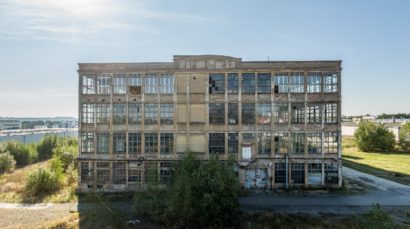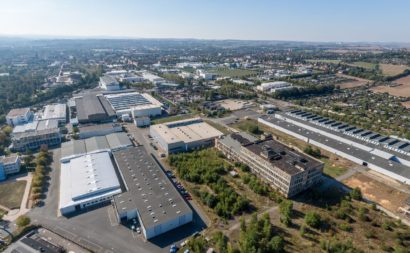Zwickau Subcamp
August 30, 1944 – April 15, 1945
![]()
The "Hochbau" of the former Horch-Werke Zwickau, 2018 (Flossenbürg Concentration Camp Memorial / Photo: Rainer Viertlböck). The prisoners were forced to work in this building. Today it remains vacant.
![]()
Aerial view of the former factory grounds in Zwickau, 2018 (Flossenbürg Concentration Camp Memorial / Photo: Rainer Viertlböck)
-
Prisoners
Over 1,000 men arrived on several transports. Along with 437 Poles (of whom 30 were Jewish) and 306 Russians registered, there were 85 Italians, over 70 French, 65 Hungarians (among them 59 Jews), 55 Czechs, 30 Germans, along with prisoners from nine other nations.
-
Forced labor and quarters
Production of army vehicles, airplanes, and torpedoes for the Horch-Werke (division of Auto-Union). The prisoners were quartered in a barracks compound on the factory grounds.
-
The management complained to the SS about the dismal state of the prisoners, which was a source of epidemics threatening the civilian workers. In February and March, more than 350 ill prisoners were transferred to Flossenbürg.
-
Guards
51 SS men. Detail leader Wilhelm Müsch, along with the sergeants Schragner and Welantschitz, shot dead 23 prisoners, because they attempted to escape the camp through a tunnel they dug.
-
Death toll
In the Flossenbürg registers, there are 280 deaths recorded. Many sick inmates died after being transferred back to Flossenbürg.
-
Disbanding of the camp / end of the war
The camp was evacuated on April 14, 1945. The prisoners were forced to first march in the direction of Flossenbürg; however due to the changing frontline situation, they marched towards the Leitmeritz subcamp.
-
Commemoration
Factories were built on the camp grounds in the 1950's, on which a commemorative plaque was mounted, memorializing the subcamp.
-
On September 11, 1948, a “Memorial to the Victims of Fascism” was unveiled at the swan pond in Zwickau Municipal Park. It was here that the urns of 320 prisoners from Zwickau and Mülsen St. Micheln had been formally interred on August 12, 1945. In the 1960s the old commemorative site was demolished. The new memorial makes no mention of the Zwickau subcamp.

